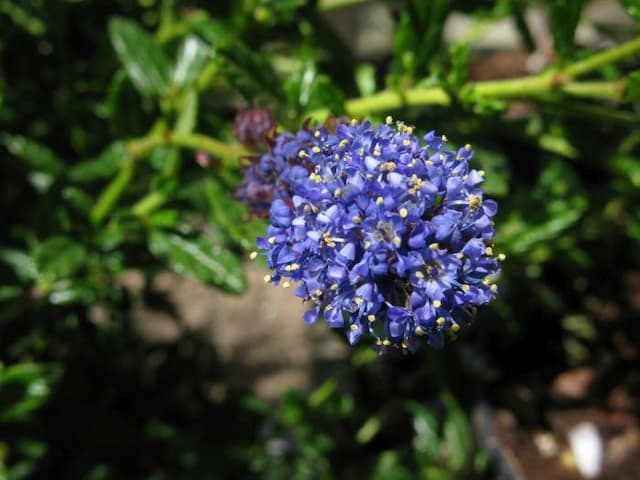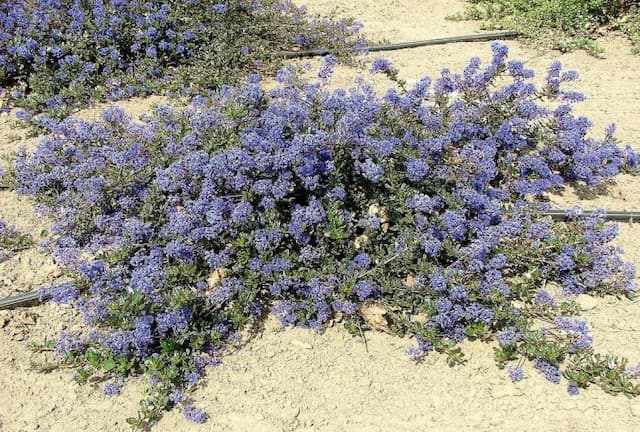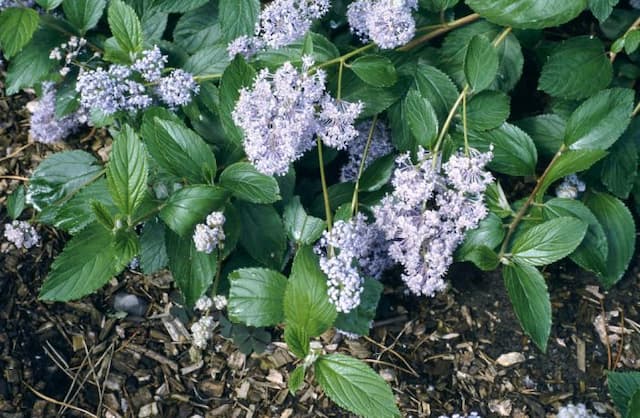Point Reyes ceanothus Ceanothus gloriosus 'Emily Brown'

ABOUT
The Emily Brown ceanothus is a striking evergreen shrub that is widely appreciated for its decorative qualities. It is characterized by a dense and lush foliage that consists of small, oval-shaped leaves. These leaves are dark green, providing a rich backdrop for the plant's standout feature: its flowers. The blossoms emerge as clustered, fluffy plumes that are a brilliant blue in color, creating a vibrant contrast against the foliage. The flowers typically appear in spring and are known for attracting various pollinators, including bees and butterflies, which adds to the plant's lively demeanor. The overall appearance of the Emily Brown ceanothus exudes a wild yet orderly aesthetic, making it a popular choice for gardeners looking to add a pop of color and texture to their landscapes. Despite its ornamental appeal, the plant's appearance is hardy and resilient, often used in coastal areas for its tolerance to salty air and drought conditions once established.
About this plant
 Names
NamesFamily
Rhamnaceae
Synonyms
Point Reyes Ceanothus, Emily Brown Ceanothus
Common names
Ceanothus gloriosus 'Emily Brown'.
 Toxicity
ToxicityTo humans
Point Reyes ceanothus, as it is commonly known, is generally not considered toxic to humans. There are no well-documented cases of poisoning from ingesting this plant. As with any non-food plant, ingestion of large quantities could potentially cause stomach upset or discomfort due to the plant's natural defense compounds, but significant toxic effects are not typically expected.
To pets
Point Reyes ceanothus is also not widely recognized as toxic to pets. Similar to its effects on humans, this plant is unlikely to cause serious harm if ingested by pets in small amounts. However, consuming large quantities could potentially lead to mild gastrointestinal upset, such as vomiting or diarrhea, because many pets have sensitive digestive systems that may react to unusual plant material.
 Characteristics
CharacteristicsLife cycle
Perennials
Foliage type
Evergreen
Color of leaves
Green
Flower color
Blue
Height
2 feet (0.61 meters)
Spread
6 feet (1.83 meters)
Plant type
Shrub
Hardiness zones
8
Native area
California
Benefits
 General Benefits
General Benefits- Attracts Pollinators: Ceanothus 'Emily Brown' is known for drawing in bees, butterflies, and other beneficial insects that play a crucial role in pollination.
- Drought Tolerance: Once established, it is highly drought-resistant, making it ideal for water-conservation landscapes or areas prone to dry spells.
- Low Maintenance: Requires minimal care once established, requiring little to no fertilization and only occasional pruning to maintain its shape.
- Erosion Control: The root system helps stabilize slopes and control soil erosion, making it a practical choice for hillside plantings.
- Year-Round Interest: With its glossy green leaves, blue flower clusters in the spring, and evergreen nature, it provides visual appeal throughout the year.
- Habitat Support: Provides food and shelter for local wildlife, including birds and insects, enhancing biodiversity.
- Fast-Growing: It's a quick grower, which can be advantageous for landscape projects that require speedy establishment or coverage.
- Native Plant Advantages: Being a native plant to certain regions, it's adapted to local conditions and supports the native ecological balance.
- Landscape Versatility: Can be used in various landscape designs, from informal cottage gardens to more formal settings, as hedges or groundcovers.
- Colorful Blooms: Offers a burst of color with its violet to blue flowers, which can enhance the aesthetic appeal of any garden.
 Medical Properties
Medical PropertiesThis plant is not used for medical purposes.
 Air-purifying Qualities
Air-purifying QualitiesThis plant is not specifically known for air purifying qualities.
 Other Uses
Other Uses- The leaves of the Ceanothus gloriosus 'Emily Brown', commonly known as 'Point Reyes ceanothus', can be used as a natural insect repellent when crushed and applied to skin.
- The dense growing habit of the Point Reyes ceanothus provides excellent cover for small wildlife, creating mini habitats for insects and birds in eco-friendly gardens.
- Fibers from the bark of the Point Reyes ceanothus were used historically by Native Americans to create strong cords and threads for various crafting needs.
- With their rich, evergreen foliage and compact form, these shrubs can be used in topiary or formal gardening, offering structure to landscape designs.
- Due to its deep root system, the Point Reyes ceanothus can be used to stabilize slopes and prevent erosion in hilly areas.
- The wood of the Point Reyes ceanothus, though not typically harvested for this purpose, can provide a hardy material for creating small wooden tools or objects.
- Dried parts of the shrub, such as leaves and seed pods, can be used to create natural potpourris or decorative filler in floral arrangements.
- The distinctive blue flowers can be used as natural dyes, providing a range of blue hues to textiles or crafts.
- Its drought-resistant qualities make the Point Reyes ceanothus an ideal candidate for xeriscaping, reducing the need for irrigation in arid climates.
- In landscape design, the shrub can also be used to form a natural barrier or screen, providing privacy without the need for man-made fencing.
Interesting Facts
 Feng Shui
Feng ShuiThe California lilac is not used in Feng Shui practice.
 Zodiac Sign Compitability
Zodiac Sign CompitabilityThe California lilac is not used in astrology practice.
 Plant Symbolism
Plant Symbolism- Resilience: The Ceanothus plant is known for its hardiness and ability to survive in poor soils, representing the ability to endure and thrive in challenging conditions.
- Independence: As members of the Ceanothus genus can fix nitrogen in the soil, they are not as dependent on soil fertility, symbolizing self-sufficiency and independence.
- Rejuvenation: Many species of Ceanothus, including the 'Emily Brown', have the ability to regenerate after being damaged, representing the concept of rebirth and starting anew.
- Patriotism: With its blue flowers, Ceanothus, commonly known as California lilac, often symbolizes loyalty and patriotic spirit, especially in the context of its native landscape in the United States.
- Attraction: The California lilac's bright and abundant blooms are known to attract butterflies and other pollinators, making it a symbol of attraction and magnetism.
 Water
WaterThe Point Reyes ceanothus should be watered deeply but infrequently to mimic its native coastal habitats. Initially, water the plant once a week with about 1-2 gallons, depending on the soil and weather conditions, to establish a strong root system. Once established, reduce watering to every two to three weeks, using 1-2 gallons each time. During the summer or hotter months, you might need to water a bit more frequently if the weather is particularly dry. Always check the top few inches of soil for dampness before watering to avoid overwatering.
 Light
LightThe Point Reyes ceanothus thrives best in full sun to partial shade. Ideally, it should receive at least six hours of direct sunlight a day. A spot that exposes the plant to morning sunlight and offers some shade in the intense afternoon heat would be optimal, as this mimics its natural coastal environment.
 Temperature
TemperaturePoint Reyes ceanothus prefers mild climates and handles a temperature range from about 10 to 100 degrees Fahrenheit. The ideal growing conditions for this plant fall within 50 to 70 degrees Fahrenheit. Prolonged temperatures above 100 degrees or below 10 degrees could harm the plant.
 Pruning
PruningPruning the Point Reyes ceanothus is important to maintain its shape and promote healthy growth. Prune in late winter or early spring before new growth begins. Remove any dead or damaged branches and cut back about one-third of the oldest branches to encourage new shoots. Thinning out dense foliage will also improve air circulation.
 Cleaning
CleaningAs needed
 Soil
SoilThe best soil mix for 'Point Reyes Ceanothus' should be well-draining with a mix of loam, sand, and organic compost, reflecting its native coastal habitats. The soil pH should ideally be slightly acidic to neutral, ranging from 5.5 to 7.5. Mulching can help maintain moisture and ensure soil health.
 Repotting
Repotting'Point Reyes Ceanothus' does not need frequent repotting; it's typically done every 2 to 3 years. Since they are adapted to grow in a specific environment, repotting is only necessary when it outgrows its pot or the soil is exhausted.
 Humidity & Misting
Humidity & Misting'Point Reyes Ceanothus' thrives in the typical outdoor humidity levels found in its natural coastal habitat. It does not require high humidity environments and will do well with average atmospheric humidity.
 Suitable locations
Suitable locationsIndoor
Provide bright light, well-draining soil, and avoid overwatering.
Outdoor
Plant in full sun, well-draining soil; protect from harsh winter.
Hardiness zone
8-10 USDA
 Life cycle
Life cycleCeanothus gloriosus 'Emily Brown', commonly known as 'Emily Brown' California lilac, begins its life as a dormant seed, requiring exposure to heat or fire scarification to break dormancy and germinate. Upon germination, the seedling establishes a root system and produces cotyledons followed by true leaves, progressively maturing into a woody shrub. During spring, it enters the flowering stage, producing clusters of attractive blue flowers that are pollinated by bees and other insects. After pollination, it sets seed in the form of small, hard capsules that can remain dormant until the right conditions for germination occur. The mature shrub can live for many years, with a growth pattern that can either be compact or spreading, offering evergreen foliage throughout its life. The plant eventually enters senescence, where growth slows and it may become more susceptible to pests and diseases before ultimately dying, completing its life cycle.
 Propogation
PropogationPropogation time
Spring to Summer
Propogation: The most popular method of propagation for the Ceanothus gloriosus 'Emily Brown', commonly known as the wild lilac or California lilac, is through semi-hardwood cuttings. This technique typically takes place during late summer, when new growth has matured and begun to harden. To propagate using this method, a cutting of about 4 to 6 inches (10 to 15 centimeters) in length is taken. The bottom leaves are removed, and the cut end can be dipped in rooting hormone to encourage root development. It's then inserted into a well-draining potting mix. The cutting needs to maintain high humidity and consistent moisture without being waterlogged. With proper care, roots should develop in a few weeks, after which the new plant can be gradually acclimatized to less humid conditions before being planted out.









